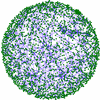
Spreading Paths in Partially Observed Social Networks
Abstract
Understanding how and how far information, behaviors, or pathogens spread in social networks is an important problem, having implications for both predicting the size of epidemics, as well as for planning effective interventions. There are, however, two main challenges for inferring spreading paths in real-world networks. One is the practical difficulty of observing a dynamic process on a network, and the other is the typical constraint of only partially observing a network. Using a static, structurally realistic social network as a platform for simulations, we juxtapose three distinct paths: (1) the stochastic path taken by a simulated spreading process from source to target; (2) the topologically shortest path in the fully observed network, and hence the single most likely stochastic path, between the two nodes; and (3) the topologically shortest path in a partially observed network. In a sampled network, how closely does the partially observed shortest path (3) emulate the unobserved spreading path (1)? Although partial observation inflates the length of the shortest path, the stochastic nature of the spreading process also frequently derails the dynamic path from the shortest path. We find that the partially observed shortest path does not necessarily give an inflated estimate of the length of the process path; in fact, partial observation may, counterintuitively, make the path seem shorter than it actually is.
Citation:
J.P. Onnela and N.A. Christakis, "Spreading Paths in Partially Observed Social Networks" Physical Review E, 85(3): 036106